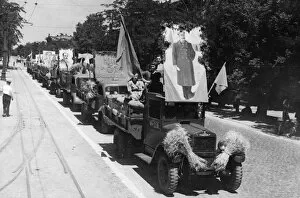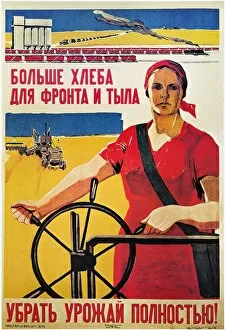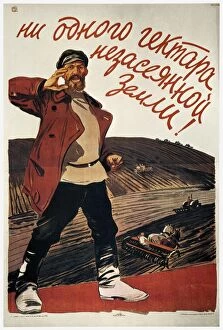Kolkhoz Collection (#2)
"Kolkhoz: A Symbol of Soviet Agriculture and Collective Effort" Step into the world of kolkhoz
For sale as Licensed Images
Choose your image, Select your licence and Download the media
"Kolkhoz: A Symbol of Soviet Agriculture and Collective Effort" Step into the world of kolkhoz, where statues of hardworking workers and Kolkhoz women stand proudly near the Cosmos. These sculptures serve as a reminder of the dedication and unity that characterized this unique agricultural system. In 1947, artist Mikhail Solovyov captured the essence in his Russian Soviet poster. It depicted the belief that those who toiled diligently during harvest time would be rewarded with an abundance of bread – a symbol of prosperity for all. Maria Voron's 1934 poster emphasized the importance of prioritizing the gathering of the Soviet harvest. It urged citizens to embrace collective effort and contribute towards building a self-sufficient nation. The Cooperation Day in a village, portrayed by artist Tcheptsov in 1926, showcased how communities came together to celebrate their achievements within kolkhozes. This event fostered camaraderie among farmers and highlighted their shared goals. Vasily Nikolaevich Kostyanitsyn's artwork from the early 1930s depicted collectivization as an opportunity for growth and progress. The paintings showcased new life emerging from collective farms, illustrating how this system brought about positive change in rural areas. Propaganda posters like "Come, comrades, and join our collective farms. " encouraged individuals to participate actively in kolkhozes. They aimed to mobilize people towards achieving agricultural success on a national scale. During challenging times such as World War II, requisitioning cattle for the Red Army became necessary. This act demonstrated how even amidst adversity, kolkhozes played a vital role in supporting national defense efforts. Movies like "Faraway Village, " released in 1931, shed light on rural life within these collective farming communities. They provided glimpses into daily routines while showcasing both challenges faced and triumphs achieved through cooperative work.



